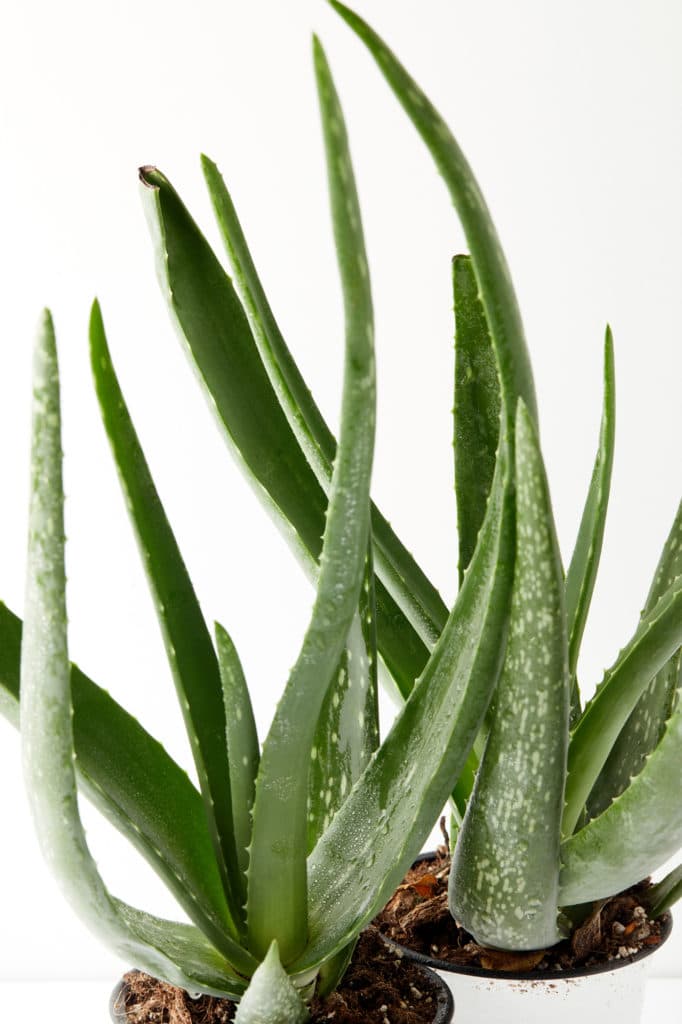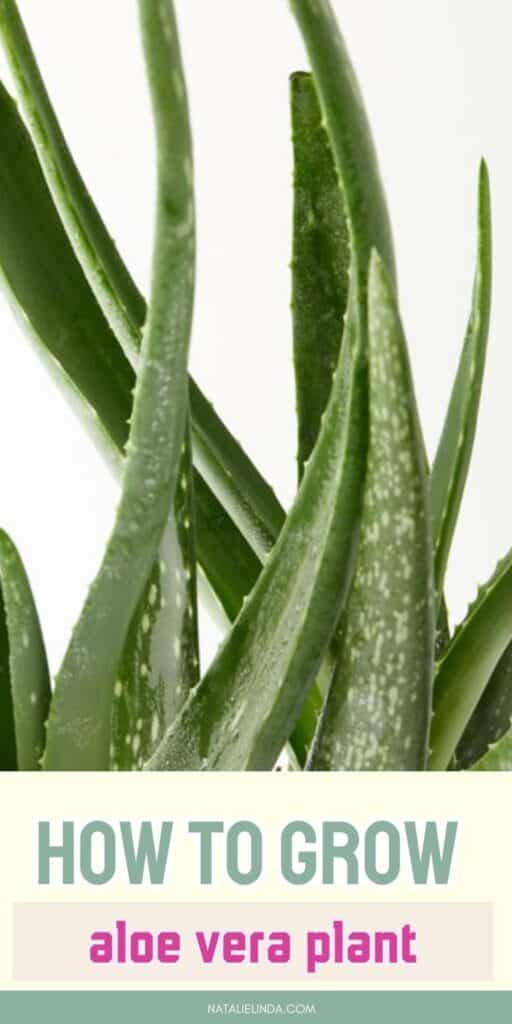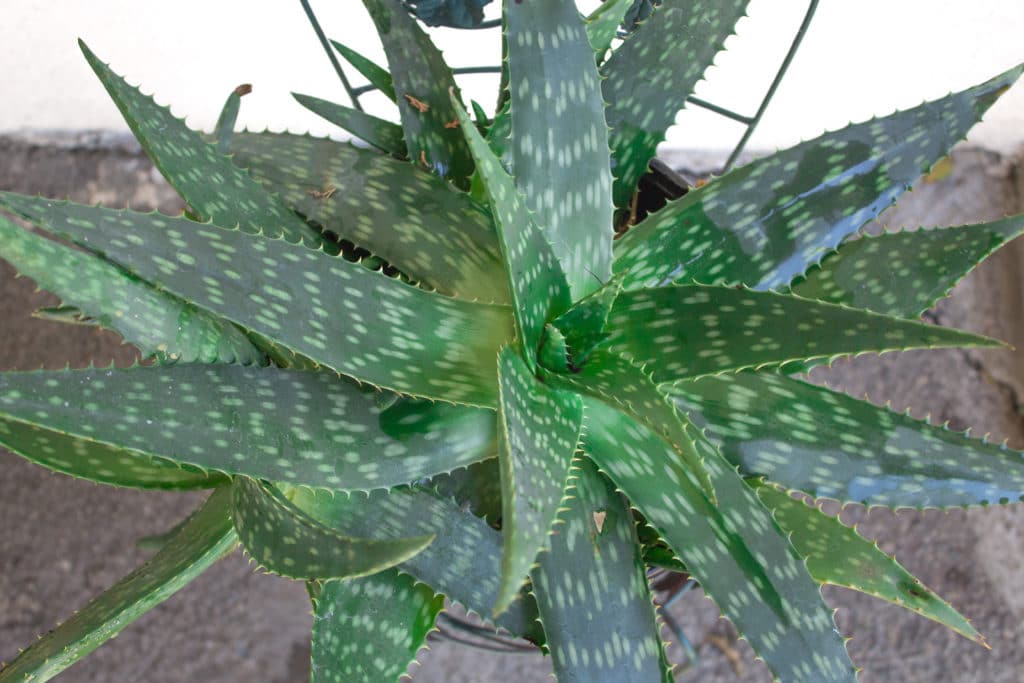Aloe Vera Plant Care: Learn to Grow This Healing Succulent
Aloe Vera is a plant you definitely want to make room for in your garden. It not only adds interest to yards or indoor spaces, it has wonderful healing and medicinal properties.
The gel produced inside the aloe vera plant can soothe sunburns and skin irritations, which is why it’s such a popular succulent. It also helps to purify the air, just as other houseplants do!
If properly cared for, a single aloe vera plant can grow for years and even decades.
Aloe vera grows very well outdoors but it can also be grown indoors, as long as it gets enough sunlight.
A fast grower, aloe vera is a low-maintenance plant that is perfect for gardening beginners, those with a succulent garden, or those who want access to fresh aloe vera gel.
Keep reading to learn about the most important steps to planting and caring for an aloe vera plant!
(This post may contain affiliate links).

How to Plant an Aloe Vera Plant
Aloe vera plants can be purchased in a variety of sizes at garden nurseries and through online retailers.
You can find a tiny aloe vera plant in a four-inch pot, or a very large one that is perfect for a sprawling outdoor space. Choose the best size for your needs, and consider how much space you have in your home or in your outdoor garden.
Also consider how often you think you’ll use the aloe vera gel – if you plant to use aloe for its medicinal properties, you might want to purchase an aloe vera plant that has already grown large leaves.
TIP: Always be careful when observing and planting aloe vera. As with other cacti, aloe vera features spiky stems that can prick your skin if handled without protective gardening gloves.
When planting your aloe vera plant, be mindful that the pot you use contains a drainage hole because proper water drainage is key for growing this plant successfully.
If planting directly into the ground, it’s best to plant in a well-draining cactus mix, to ensure proper drainage.
As with other succulents, aloe vera does not do well in soggy soil, so keeping the soil overly moist is a sure way to kill your plant!
You can grow aloe vera in any pot, but I recommend using terra cotta pots when growing succulents because it ensures better airflow and also wicks water away from the pot instead of holding it in.
Plus, plastic pots can retain too much heat, especially if placed outdoors in full sun.
If you’re repotting your aloe vera pot after purchasing it, make sure to choose a pot that can accommodate the root ball plus a few inches for the roots to continue growing.
Place your plant inside the pot and fill it with cactus mix aka succulents soil.
Since aloe vera needs good soil drainage, opt for cactus soil over regular potting soil.
A good cactus mix will contain particles such as pumice and sand to ensure that excess water is able to quickly travel through the soil.
How Often to Water an Aloe Vera Plant
Knowing how often to water an aloe vera plant depends on a number of factors including climate, humidity, and whether it’s being grown indoors or outdoors.
Generally speaking, you should water aloe vera about every few days to once a week.
Aloe vera is a very drought-tolerant plant that stores water in its leaves, so you should only water it when the soil is dry to the touch.
An easy way to test whether your plant needs water is to touch its soil. Simply stick your finger into the soil about an inch deep. If it feels dry, then it’s time to water!
If it feels moist, test again in a few more days.
When it’s time to water, take your watering can or watering hose, and gently water the soil, not the actual plant or leaves.
Once you see water drain from the drainage hole, it’s time to stop watering – your plant has received enough moisture.
To learn more about watering succulents, read my post about How to Water Succulents – the Right Way!
Your Aloe Vera Plant Needs Full Sun
Aloe vera needs plenty of sunlight to grow optimally.
If you’re growing aloe vera indoors, try to place your plant near a south-facing window that gets a few hours of sunlight each day.
If growing aloe vera outdoors, make sure to place in a spot that gets full to part sun through the day.
You can keep your potted aloe vera indoors during the colder months, and move the pot outdoors during spring and summer so the plant gets the light it needs during its growing season.
If you notice that your plant’s leaves are looking sunburnt, however, move your pot to an area of your yard that gets more filtered shade, such as on a porch or under a tree or shrub.
How to Fertilize an Aloe Vera Plant
Fertilizing aloe vera plants can help them grow, but it’s not a necessary step since they can thrive without it.
If you opt to fertilize, always use organic fertilizer because they’re more gentle on plants. I personally use a liquid kelp fertilizer for my plants, and I love it.
It’s important to get the timing right: fertilize during the active growing season and never during fall and winter because that’s the plant’s dormant period.
During Spring and Summer, you can add liquid fertilizer to your plant once a month, according to instructions on the label, or at half strength.
Always make sure, however, that the soil is moist before applying fertilizer because fertilizing when the soil is dry can shock the plant.
Dealing with Plant Pests and Diseases on Your Aloe Vera Plant
Luckily, growing aloe vera doesn’t present too many problems in the way of insects and plant diseases.
However, it’s always best to be proactive. As with other succulents, aloe vera can fall prey to mealybugs. What are mealybugs?
Mealybugs are fast-spreading insects that feed off the sap of succulents. If not dealt with quickly, they can ruin your plant and spread from plant to plant.
If you see white, cotton-like mounds on the leaves and base of your aloe vera plant, you most likely have a mealybug problem. Don’t worry!
There’s a simple solution for getting rid of the problem, as long as you have rubbing alcohol on hand!
If you only see a few little white mounds on your aloe vera plant, simply dip a Q-tip in rubbing alcohol and swab away the mealybugs until they are no longer visible; this should resolve your bug problem.
However, if you plant is covered in mealybugs, you can try to salvage it but mixing alcohol and water.
Using a watering can or spray bottle, drench your entire plant, including the leaves and the soil, with the alcohol solution.
Do this for a few days until you no longer see the mealybugs; this will give your plant a good chance of surviving this insect infestation.
While you deal with your mealybug problem, make sure to isolate the infected plant to shield your other plants from succumbing to this fast-spreading insect.
For more about mealybugs, read my How to Get Rid of Mealybugs post.
WANT TO REMEMBER THIS POST FOR FUTURE REFERENCE? SAVE THE PIN BELOW TO YOUR FAVORITE PINTEREST BOARD!

To learn more about Succulents and Indoor Houseplants, check out the posts, below!
How to Water Succulents – the Right Way
How to Care for a Jade Plant
How to Propagate Succulents from Leaves
How to Care for a Pothos Plant
How to Care for an Anthurium Houseplant

